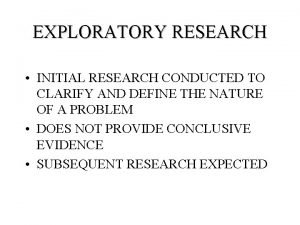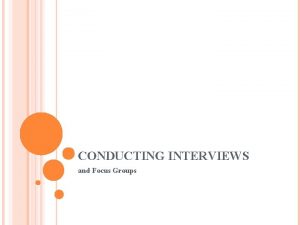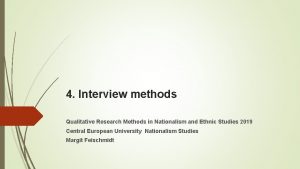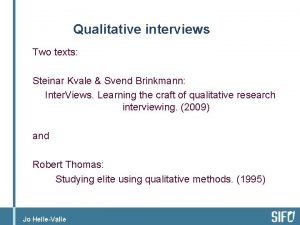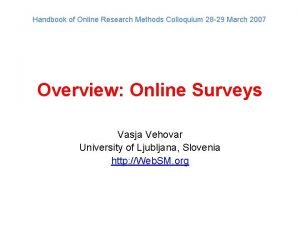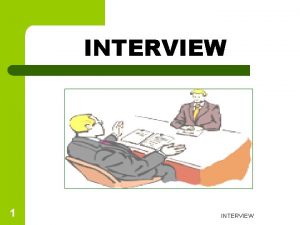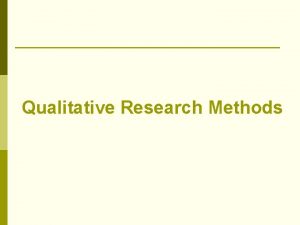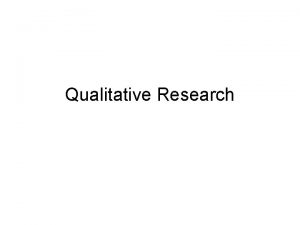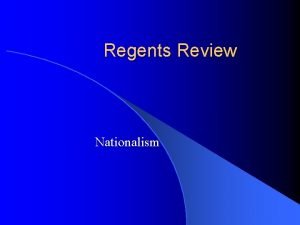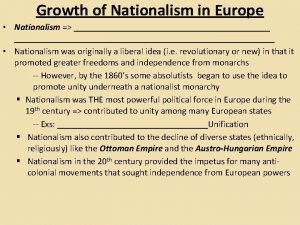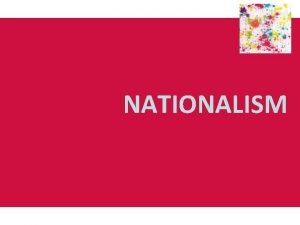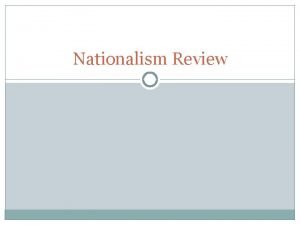4 Interview methods Qualitative Research Methods in Nationalism














- Slides: 14

4. Interview methods Qualitative Research Methods in Nationalism and Ethnic Studies 2019 Central European University Nationalism Studies Margit Feischmidt

Topics and Readings Topics Readings: Structure, setting, and the role of the interviewer Bernard, R (2006): Unstructured and semi -structured interviewing. In Bernard R. Research Methods in Anthropology. Oxford: Altamira Press, 208 -236 Interview types based on the research aim and degree of control Oral history, narrative interview Semi-structured individual interview Focus group interview Interview guide examples: semi-structured and structured individual interview Interview guide example and exercise (In the class make a draft of your interview guide wording, order, and content of questions) Briggs, Charles (1983) Learning how to Ask. Cambridge: CUP. Chapter 5 93 -111. Holstein, James and Jaber Gubrium (1997) Active Interviewing. In: Silverman, David (ed. ) Qualitative research: theory, method, and practice. London, Sage 113129

Interview types based on the degree of control 1. Informal interview lack of structure or control, remembered conversations 2. Unstructured interview – or ethnographic interview based on a clear plan, kept in the researcher’s mind: let people to open up and express themselves 3. Semi structured interview guide: a list of topics and related questions to be covered (order) the same guide – makes inter-case comparison possible formal, written guides are mandatory if one works with several interviewers 4. fully structured interview the topic, the order and formulation of the questions are identitcal in every situation, the stimuli shoud be the same interview schedule: instructions how to administer the questionnaires

General advises Starting an unstructured interview assure anonymity, explain how the informant was chosen assure that her participation is crucial you want to learn from her/him asking for permission to record Letting the informant to lead you keep the conversation focused on the topic (difference from everyday conversations) but: let the informant to define the content supportive, polite relations → informants comfort feeling to answer be aware the vocabulary, the relevance and the grade of intimacy of your topic in the studied society The uses of unstructured interview for building initial rapport, before more formal interviews for studying sensitive issues (like sexuality)

How to stimulate more information? The silent probe just remain quiet and wait for your informant to continue (sometimes difficult); some informants require very little prodding, others more The echo probe repeat the last words, ideas of your informant asking her to continue it is neutral and doesn’t redirect the interview The Un-Uhuh probe encourage the informant to continue just making affirmative voices (uh-uhuh, yes, I see) Phased Assertion or baiting most people are more comfortable, if you show that you have the basic knowledge on the topic Ethics of Questioning the better you get at making informants “open up”, the more responsible you become towards them

Learning to interview Practice in front of others, an experienced interviewer can criticize your performance – EXERCISE Try your guideline before starting the real interviewing – pilot! How many interviews? 40 -60 interviews even in smaller projects all relevant sub-groups/categories should be covered → qualitative representation saturation point: no more news, every interview is a repetition of a previous one Don’t show your disapproval with your interviewee Use tape-recorder in all cases (taste your recorder before every interview), Tape your interviews and add your notes on circumstances

Response issues The expectancy effect sensitive issues: the answers depend on how the interviewer’s relation to the topic is understood ex. white voters asked whom they vote for, were more likely to claim the African-American candidate if the interviewer was African-American than if the interviewer was white less dependence on subjective positions – in topics less race/ethnicity/gender related expectancy different from distortion Accuracy of data. How inaccurate data is produced? 1. informants may report what they suppose happened rather than what they actually saw 2. informants may distort what they see to conform to their own prejudices 3. informants’ memories simply fail them 4. informants will usually try to answer all your questions once they agreed to be interviewed 5. informants sometimes lie simply because they want to mislead you

Learning how to ask (Ch Briggs) Incorporating methodological implications of ethnography of communication, conversational analysis, language research → a four-phrase approach of conducting interviews and interpreting the result Phase 1: learning how to ask Understanding the communicative norms of the society in question → adequate application of interview techniques participate and observe spontaneous talk events on the focus of the study learn how your topics can be asked, what type of questions are appropriate in certain situations (and what is inappropriate)

Phase 2: designing an appropriate methodology Based on Phase 1 – reconsider: which topics can be explored with interviews, with whom and under which circumstances what issues will have to be explored by other means modify the interview plan in order to make it compatible with local speech habits interviews supplemented by observations —notes on, during and after the interviews tape recordings crucial, videotaping advisable (shows the nonverbal communication in detail + can be attractive in the field)

How to design an interview guide What do we want to learn from the interview? Research topics/questions → Interview topics/questions (never the same) Topics and related sub-topics of the interview defined How far should be comparable? How far are we interested in the personal background? How do we want to learn it? Direct or indirect questions Structured, un- or semi-structured interview Narrative (life-stories and trajectories in the focus), Topic-oriented: structured or semistructured Combination of narrative and semi-structured interview Focus group interview

Type of interviews – the narrative interview, G. Rosenthal Theoretical roots in phenomenology+psychoanalysis Used in studies on individual memories on social events/phenomena, social/ethnic identities (topics in the intersection of social and individual) Structure: 1. Part: the main narrative – a life history After saying some words about the aim of the study we start with an open question referring to (whole or part of) the respondent’s life trajectory No more questions while she/he is telling her life-story 2. Part – narrative questions and answers Questions of the 2. refer back to 1. (echo- and uh-uh-probe)

Type of interviews – the phenomenological semistructured interview, Seidman Structure (1) Narrative part - focused life-story (2) Phenomenological part – reconstruction of concrete personal memories, experiences concerning the topic (3) Hermeneutical part – the personal and local meanings of related themes

The focus group interview. How to do? To know aims, arguments, positions of public issues, disputes by reproducing them in a methodologically controlled way (study of local conflicts etc. ) Moderated and focused discussion! Moderator leads the discussion, participants talk to each other (not to the moderator, individual questions and answers are wrong) Participants: 6 -12 members + moderator the group of participants homogeneous in certain respect, but usually don’t know each other: must consist of strangers if the aimed population is larger - groups stratified by age, sex, social status etc. Interaction: different positions and opinions developing in interaction Requires special facilities (professional space with an observation room, but can be also a meeting room)

Planning and conducting focus group interviews The guide List of topics what you want to cover List of the techniques how you want to cover those topics (question and projective techniques) Decide whether you want A) a relatively unstructured and open-ended interview: explorative B) a more structured discussion: depth and detail on precise questions The moderator Produces lively discussions on topics which should be covered Initiates interactions reaching a group dynamic Group discussion usually produces conformity, the moderator minimizes it Group discussions usually dominated by some of the participants, the moderator tries to control them and support others
 Erin whiteside
Erin whiteside Exploratory research is __________.
Exploratory research is __________. What is qualitative questions
What is qualitative questions What is an interview guide in qualitative research
What is an interview guide in qualitative research Qualitative field research
Qualitative field research Steinar kvale
Steinar kvale Qualitative research methods in political science
Qualitative research methods in political science Qualitative vs quantitative research
Qualitative vs quantitative research What is the sample size in qualitative research?
What is the sample size in qualitative research? Visual methods in qualitative research
Visual methods in qualitative research Qualitative research methods
Qualitative research methods Sampling methods in qualitative and quantitative research
Sampling methods in qualitative and quantitative research Teacher as a researcher
Teacher as a researcher Qualitative research methods
Qualitative research methods Qualitative research methods
Qualitative research methods

